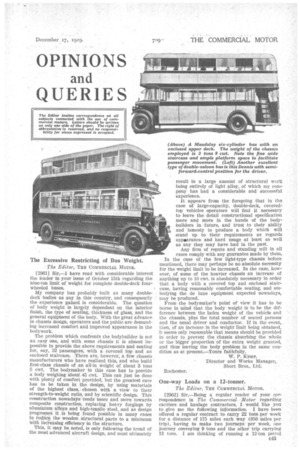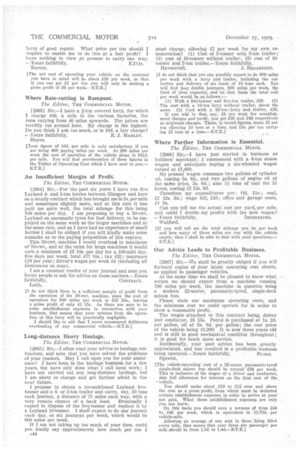OPINIONS
Page 65

Page 66

If you've noticed an error in this article please click here to report it so we can fix it.
and
QUERIES
The Excessive Restricting of Bus Weight.
The Editor, THE COMMERCIAL MOTOR.
[2961] Sir,-1 have read with considerable interest the leader in your issue of October 15th regarding the nine-Ion limit of weight for complete double-deck fourwheeled buses.
My company has probably built as many doubledeck bodies as any in this country, and consequently
the experience gained is considerable. The question•of body weight is largely dependent on the interior finish, the type of seating, thickness of glass, and the general equipment of the body. With the great advance in chassis design, operators and the public are demanding increased comfort and improved appearance in the
bodywork. • The problem which confronts the bodybuilder is not an easy one, and with some chassis it is almost impossible to provide the above requirements and seating for, say, 52 passengers, with a covered top and an enclosed staircase. There are, however, a few chassis manufacturers who have realized this, and who build first-class chassis of an all-in weight of about 3 tons 5 cwt. The bodyinaker in this case has to provide a body weighing about 45 cwt. This can just be done with plenty of comfort provided, but the greatest care has to be taken in the design, by using materials of the highest class, chosen with a view to their strength-to-weight ratio, and by scientific design. This construction nowadays tends more and more towards composite construction, replacing heavy forgings by aluminium alloys and high-tensile steel, and as design progresses it is being found poSsible in many cases to redttce the wooden structural parts to a minimum with increasing efficiency in the structure. This, it may be noted, is only following the trend of the most advanced aircraft design, and must ultimately result in a large amount of structural work being entirely of light alloy, of which my company has had a considerable and successful experience.
It appears from the foregoing that in the case of large-capacity, double-deck, coveredtop vehicles operators will find it necessary to leave the detail constructional specification more and more in the hands of the bodybuilders in future, and trust to their ability and honesty to produce a body which will stand up to their requirements as regards appoarance and hard usage at least as well as any they may have had in the past.
Any firm of repute and standing will in all cases comply with any guarantee made by them.
In the case of the few light-type chassis before mentioned, there may perhaps be no absolute necessity for the weight limit to be increased. In the case, however, of some of the heavier chassis an increase of anything up to 10 cwt. is absolutely necessary in order that a body with a covered top and enclosed staircase, having reasonably comfortable seating, and embodying the de luxe equipment expected nowadays, may be produced.
From the bodymaker's point of view it has to be borne in mind that the body weight is to be the difference between the laden weight of the vehicle and the chassis, plus the total number of seated persons and the usual driver and conductor. If in the event, then, of an increase in the weight limit being obtained, it seems only reasonable that means should be provided in order to prevent the chassis absorbing the whole or the bigger proportion of the extra weight granted, and thus leaving the body problem in the same condition as at present.—Yours faithfully,
f2962] Sir,—Being a regular reader of your correspondence in The Commercial Motor regarding carriers and haulage contractors, I would like you to give me the following information. I have been offered a regular contract to carry 22 tons per week for a distance of 175 miles each way (350 miles per trip), having to make two Journeys per week, one journey conveying 9 tons and the other trip carrying 13 tons. I am thinking of running a 12-ton petrol lorry of good repute. What price per ton should I require to enable me to do this at a fair profit? I have nothing in view ,at present to carry one way. –7-Yours faithfully,
Exeter,
[The net cost of operating your vehicle on the contract you have in mind will be about £36 per week, so that if you can get £2 per ton you will only be making a gross profit of £6 per week.—S.T.R.] Where Rate-cutting is Rampant.
The Editor, .THE COMMERCIAL MOTOR.
• [2963] Sir,—I have a 2-ton covered lorry, for which I charge 100. a mile tO the various factories, the runs varying from 40 miles upwards. The prices are terribly cut around here. My charge is the highest. Do you think I ask too much, or is 100. a fair charge?
—Yours faithfully, E. J. MANLEY. Hayes.
[Your figure of 100. per mile is only satisfactory if you are doing 400 paying miles per week. At 200 miles per week the cost of operation of the vehicle alone is 10id. per mile. You will find corroboration of these figures in the Tables of Operating Cost which I have sent to you.— S.T.R.] An Insufficient Margin of Profit.
The Editor, TEE COMMERCIAL MOTOR.
12964] Sir,—For the past six years I have run five Leyland 4and 5-ton lorries between Glasgow and here on a steady contract which has brought me in is. per-mile and sometimes slightly more, and at this rate it has paid me quite well, the total mileage for this being 100 milesper day. I am proposing to buy a 50-cwt. Leyland on pneumatic tyres for fast delivery, to be employed on the same work as the larger machines and at the same rate, and as I have had no experience of small lorries I shall be obliged if you will kindly make some remarks as to the paying proposition of this venture.
This 50-cwt. machine I would overload to maximum of 70-cwt. and at the rates for large machines it would earn a minimum of £3 10s. per day for a 100-mile day, live days per week, total 1.17 10s. ; tax £32; insurance £.18 per year ; driver's wages per week £4 (including all insurances on man).
, I am a constant reader of your journal and note you invite people to ask for advice on these matters.—Yours
faithfully, CONTRACT.
Leith. •
[I do not think there is a sufficient margin of profit from the operation of the 50-cwt. machine, since the cost of operation for 500 miles per week is £15 15s., leaving
a gross profit of only 15s. As there are sure to be some establishment expenses in connection with your business, that means that your revenue from the operation of this lorry will be practically negligible.
I should like to add that 1 never recommend deliberate overloading of any commercial vehicle.—S.T.R.] Long-distance Heavy Haulage, The Editor, TEE COMMERCIAL MOTOR.
[2965] Sir,—I often read your advice to haulage contractors, and note that you have solved the problems of your readers. May I call upon you for your assist. ance? I have been in the haulage business for a few years, but have only done what I call local wOrk ; I have not carried out any long-distance haulage, but I am about to change and get farther afield in the near future.
I propose to obtain a reconditioned Leyland fivetonner and a 4or 5-ton trailer and carry, say, 10 tons each journey, a distance of 75 miles each way, with a Very remote chance of a back load. Eventually I expect to dispose of the five-tonner and replace it by a Leyland 10-tonner. I shall expect to do one journey each day, or six journeys per week, which would be 900 miles per week.
If I am not taking up too much of your time, could you kindly say approximately how much per ton I e44 must charge, allowing £5 per week for my own re_ muneration ? (1) Cost of 5-tonner with 5-ton trailer ; (2) cost of 10-tonner without trailer ; (3) cost of 10tomer and 5-ton trailer.—Yours faithfully,
Havercroft. J.. BROADBENT.
[I do not think that you can possibly expect to do 900 miles per week with a lorry and trailer, including the collection and delivery of six loads of 10 tons each. You will find four double journeys, 600 miles per week, the limit of your. capacity, and on that basis the total cost . per week would be as follows (1) With a five-tonner and five-ton trailer, £30. (2) The cost with a 10-ton lorry without trailer; about the same. (3) Cost with a 10-ton .lorry and trailer,..
If you add to that, say, £8 per week for estalishment charges and profit, you get £38 and 144 respectively as minimmn charges. These, in round figures,mean £1 per ton carrying 10 tons at a time, and 15s. per ton carrying 15 tons at a time.—S.T.R.] Where Further Information is Essential.
The Editor, THE COMMERCIAL MOTOR.
• [2966] Sir,—I have just started in business as builders' merchant ; I commenced with a 6-ton steam wagon and anticipate buying a six-wheeled wagon valued at £1,400. My present wagon consumes two gallons of cylinder oil, costing 5s. 60., and two gallons of engine oil at the same price, 5s. 60.; also 1 tons of coal for 55 hours, costing £2 12s. 3d.
Therefore my expenditures are : Oil, us.; coal, £2 12s. ed.; wage bill, £10; office • and garage costs, £1 5s
Can you tell me the actual cost per yard, per mile; and could I double my profits with the new wagon?
—Yours faithfully, INTERESTED. Watford.
[If you will tell me the total mileage you do per week and how many of those miles are run with the vehicle empty, then I shall be able to deal with your questions.— S.T.R.] Our Advice Leads to Profitable Business.
The Editor, TRE COMMERCIAL MOTOR.
[2967] Sir,—We shall be greatly obliged if you will forward copies of your latest operating cost sheets, as applied to passenger vehicles.
At the same time we shall be pleased to know what return we should expect from a machine running 786 miles per week, the machine in question being a modern 32-seater, pneumatic-tyred, single-deck saloon bus.
Please state our maximum operating costs, and the minimum cost we could operate for in order to show a reasonable profit.
The wages attached to this contract being, driver and conductor, £6 158. Petrol is purchased at Is. 20. per gallon, oil at 2s. 6d. per gallon; the cost price of the vehicle being £1,200. It is now three years old and is still in good mechanical condition throughout; it is good for much more service.
Incidentally, your past advice has been greatly appreciated, and has resulted in a profitable business
being operated.—Yours faithfully, BUSES. Sliewen, [The vehicle-operating cost of a 32-seater pneumatic-tyred single-deck saloon bus should be around ' £34 per week. This is inclusive of the wages of a driver and conductor, also full allowance for interest on the first cost of the vehicle.
You should make about £10 to £12 over and above the cost as a gross profit, from which must be deducted certain establishment expenses in order to arrive at your net gain. What those establishment expenses are only you can know.
On this basis you should earn a revenue of from £44 to £46 per week, which is equivalent to 13.750. Per Allowing an average of one seat in three being filled every mile, that means that your fares per passenger per mile should be from 1:M. to












































































































